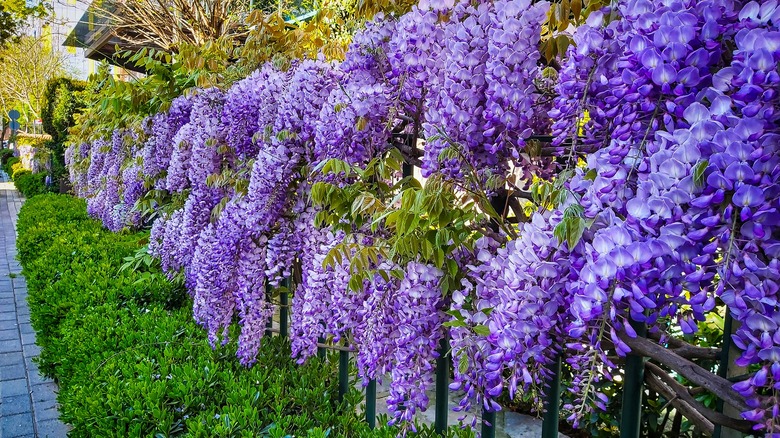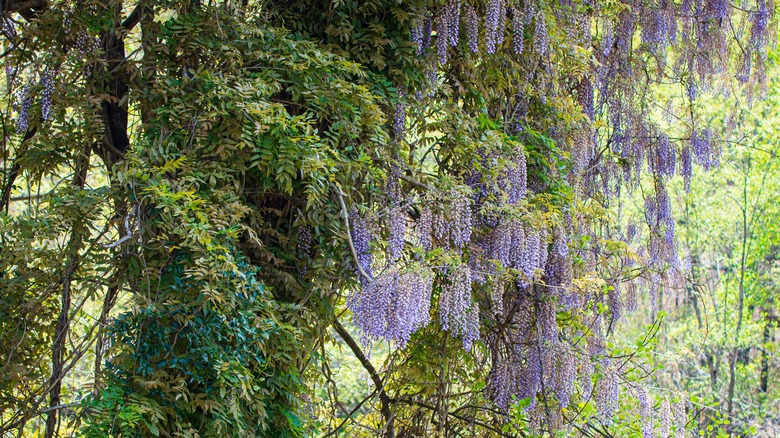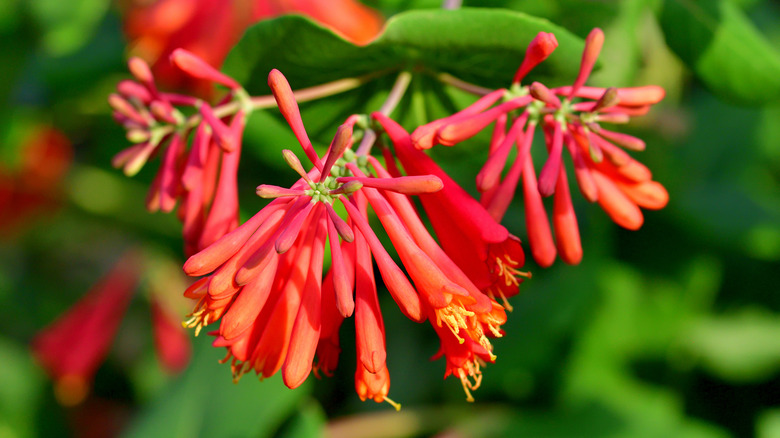Are The Big Blooms Of The Invasive Japanese Wisteria Really Worth It?
The massive purple flowers of the Japanese wisteria (Wisteria floribunda) make it hard to resist adding this fast-growing vine to your landscape. Not only does it quickly cover fences or trellises making it a beautiful privacy screen, but its romantic drooping purple flowers look like something out of a painting. Unfortunately, the Japanese wisteria's aggressively fast-growing nature and invasiveness make it a poor choice for growers in the United States.
Japanese wisteria, as its name suggests is native to Japan. It, along with its close relative Chinese wisteria (Wisteria sinensis), is a popular ornamental plant in parts of the United States. Hardy to as cold as zone 4, Japanese wisteria can grow in a wide range of soil and prefers full sun. Frustratingly for gardeners who may have chosen it for its beautiful flowers, Japanese wisteria can take up to 15 years to begin flowering when it's grown from seed.
Japanese wisteria issues and removal strategies
Japanese wisteria is a long-lived and strong vine that can crush fencing and kill trees that it climbs on. Once established, Japanese and Chinese wisteria are notoriously difficult to remove and can quickly take over yards and forests, outcompeting native plants. The vines not only compete for soil nutrients but also grow over the top of trees, preventing the host plant from receiving enough light. Additionally, because wisteria vines are so strong, they can damage the bark around a tree they climb on, eventually killing the tree, making it essential to learn strategies for removing these invasive vines.
As gardeners who have tried to get rid of wisteria can attest, when wisteria vines are cut back, they can quickly grow back from even small portions of roots. The University of Florida recommends "painting" glyphosate over the stem after cutting to prevent regrowth. Wisteria can also be removed by digging up the whole plant. Unfortunately, this strategy may not be realistic for established plants with large root systems.
Japanese wisteria alternatives
One obvious alternative to Japanese wisteria is American wisteria, Wisteria frutescens. Native to the Eastern United States, American wisteria is hardy in zones 5 to 8. Not only does American wisteria have the same fragrant purple flowers as its relatives, but it's less aggressive, making it less likely to damage fences and other structures it climbs on. American wisteria grows well in neutral to slightly acidic soil and can thrive in both sun and shade. American wisteria, unlike its invasive relatives, blooms in summer instead of spring.
Another beautiful native vine to consider is the trumpet honeysuckle (Lonicera sempervirens). The trumpet honeysuckle is another North American native with beautiful flowers, generally in shades of reds and yellows. Hardy in zones 4 through 9, it even remains evergreen in more southern regions. While its flowers aren't often fragrant, they are popular with hummingbirds and pollinators and the vine's quick growth makes it a good option for gardeners looking to quickly cover a fence or trellis.



